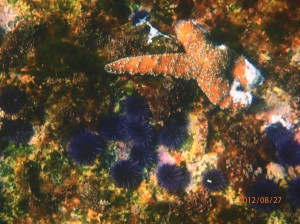
People might be frolicking in the warmer ocean waters lapping along Laguna Beach’s coastline in recent weeks, but for some ocean plants and creatures, they’ve been too long in the stew.
According to Laguna Beach’s Ocean Foundation, which strives to protect the town’s ocean habitat and tidepools, the people-pleasing sea star (formerly known as star fish) has been “wasting away,” or slowly boiling to death, in the warmer waters.
The foundation’s tidewater docents recently observed the sea stars, an echinoderm species that prefers cooler waters and lives over much of Laguna’s rocky coast, suffering from “wasting disease,” according to board member Mia Davidson. She said the condition may be caused by a bacterium associated with warm ocean water temperatures. Sea urchins are speculated to be suffering the same fate with an increased number of their shells being seen along the coast and in the tidepools, Davidson added.
“At the Ocean Institute,” said Jake Bonus, education coordinator, “we call it melting disease. It means they slowly disintegrate. They just waste away while still alive.” Bonus said it’s a normal occurrence in warmer-than-usual waters.
With cooler ocean temperatures during the previous two summers, Dana Wharf Sportfishing said late-summer warm water this year is boosting the numbers of game tropical fish, like the Dorado (mahi-mahi) and yellowtail, typically seen along the Baja California peninsula.
Brightly colored smaller fish species also more commonly found along the tropical Baja peninsula have been observed by divers and snorkelers, which means they’re following warmer waters north, while the usual fish found here also move north to find cooler waters. One diver commented that he felt like he was swimming off of Puerta Villarta.
Kelp, which also prefers cooler water, is also affected with more die-off coming up on shore, said Jan Sattler, another foundation board member. Three piles of kelp recently have been raked off the beach near the Heisler Park tidepools north of the city’s Main Beach.
As has occurred over the past three decades, similar declines and losses are common when water temperatures stay above 70 degrees for an extended period of time, Davidson said. A period of warmer water is also a common occurrence for the Southern California coastline, added Bonus, and happens most summers.
A westerly wind has cooled the ocean temperature this week but forecasters expect another surge of warmer water in early September due to a tropical storm off of Baja being observed by the National Hurricane Center.
The ochre sea star, a favorite to observe for ocean-lovers, is found in a broad range of colors from bright orange to maroon, purple and brown and can live as long as 20 years.
The Pacific Marine Mammal Center, which rescues and rehabilitates sick and wounded ocean mammals, said, that even though seals and sea lions recognize the fish they commonly eat and may not be attracted to visiting fish species, patient numbers are down and the ocean-dwelling mammals appear to be enjoying a healthy summer.




